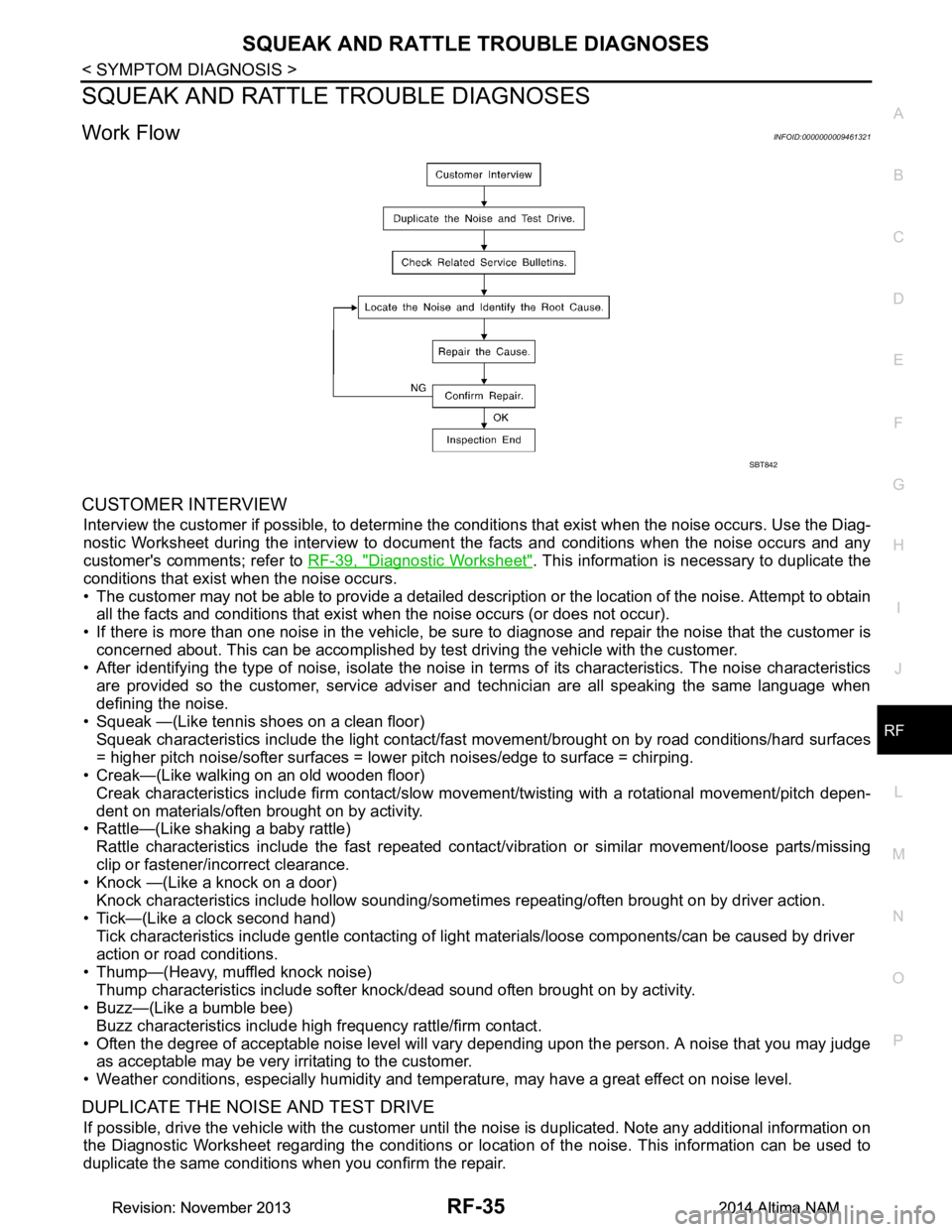2014 NISSAN TEANA lock
[x] Cancel search: lockPage 3637 of 4801
![NISSAN TEANA 2014 Service Manual
PWC-130
< SYMPTOM DIAGNOSIS >[LH & RH FRONT ANTI-PINCH]
FRONT PASSENGER SIDE POWER
WINDOW ALONE DOES NOT OPERATE
FRONT PASSENGER SIDE POWER WI NDOW ALONE DOES NOT OPER-
AT E
Diagnosis ProcedureINFOI NISSAN TEANA 2014 Service Manual
PWC-130
< SYMPTOM DIAGNOSIS >[LH & RH FRONT ANTI-PINCH]
FRONT PASSENGER SIDE POWER
WINDOW ALONE DOES NOT OPERATE
FRONT PASSENGER SIDE POWER WI NDOW ALONE DOES NOT OPER-
AT E
Diagnosis ProcedureINFOI](/manual-img/5/57390/w960_57390-3636.png)
PWC-130
< SYMPTOM DIAGNOSIS >[LH & RH FRONT ANTI-PINCH]
FRONT PASSENGER SIDE POWER
WINDOW ALONE DOES NOT OPERATE
FRONT PASSENGER SIDE POWER WI NDOW ALONE DOES NOT OPER-
AT E
Diagnosis ProcedureINFOID:0000000009460970
1. CHECK POWER WINDOW AND D OOR LOCK/UNLOCK SWITCH RH
Check power window and door lock/unlock switch RH.
Refer to PWC-100, "FRONT POWER WINDOW SWITCH : Component Function Check"
.
Is the inspection result normal?
YES >> GO TO 2.
NO >> Repair or replace the malfunctioning parts.
2. CHECK POWER WINDOW AND DOOR LOCK/ UNLOCK SWITCH RH SERIAL LINK CIRCUIT
Check power window and door lock/unlock switch RH serial link circuit.
Refer to PWC-124, "FRONT POWER WINDOW SWITCH : Component Function Check"
.
Is the inspection result normal?
YES >> GO TO 3.
NO >> Repair or replace the malfunctioning parts.
3. CHECK FRONT POWER WINDOW MOTOR RH CIRCUIT
Check front power window motor RH circuit.
Refer to PWC-107, "PASSENGER SIDE : Component Function Check"
.
Is the inspection result normal?
YES >> Check intermittent incident. Refer to GI-43, "Intermittent Incident".
NO >> Repair or replace the malfunctioning parts.
Revision: November 20132014 Altima NAMRevision: November 20132014 Altima NAM
Page 3645 of 4801
![NISSAN TEANA 2014 Service Manual
PWC-138
< SYMPTOM DIAGNOSIS >[LH & RH FRONT ANTI-PINCH]
POWER WINDOW LOCK SWIT
CH DOES NOT FUNCTION
POWER WINDOW LOCK SWITCH DOES NOT FUNCTION
Diagnosis ProcedureINFOID:0000000009460978
1. REPLACE MA NISSAN TEANA 2014 Service Manual
PWC-138
< SYMPTOM DIAGNOSIS >[LH & RH FRONT ANTI-PINCH]
POWER WINDOW LOCK SWIT
CH DOES NOT FUNCTION
POWER WINDOW LOCK SWITCH DOES NOT FUNCTION
Diagnosis ProcedureINFOID:0000000009460978
1. REPLACE MA](/manual-img/5/57390/w960_57390-3644.png)
PWC-138
< SYMPTOM DIAGNOSIS >[LH & RH FRONT ANTI-PINCH]
POWER WINDOW LOCK SWIT
CH DOES NOT FUNCTION
POWER WINDOW LOCK SWITCH DOES NOT FUNCTION
Diagnosis ProcedureINFOID:0000000009460978
1. REPLACE MAIN POWER WINDOW AND DOOR LOCK/UNLOCK SWITCH
Replace main power window and door lock/unlock switch.
Refer to PWC-142, "Removal and Installation"
. After that, PWC-99, "POWER WINDOW MAIN SWITCH : Spe-
cial Repair Requirement".
>> INSPECTION END
Revision: November 20132014 Altima NAMRevision: November 20132014 Altima NAM
Page 3646 of 4801
![NISSAN TEANA 2014 Service Manual
DOOR KEY CYLINDER SWITCH DOES NOT OPERATE POWER WINDOWS
PWC-139
< SYMPTOM DIAGNOSIS > [LH & RH FRONT ANTI-PINCH]
C
D E
F
G H
I
J
L
M A
B
PWC
N
O P
DOOR KEY CYLINDER SWITCH DOES NOT OPERATE POWER W NISSAN TEANA 2014 Service Manual
DOOR KEY CYLINDER SWITCH DOES NOT OPERATE POWER WINDOWS
PWC-139
< SYMPTOM DIAGNOSIS > [LH & RH FRONT ANTI-PINCH]
C
D E
F
G H
I
J
L
M A
B
PWC
N
O P
DOOR KEY CYLINDER SWITCH DOES NOT OPERATE POWER W](/manual-img/5/57390/w960_57390-3645.png)
DOOR KEY CYLINDER SWITCH DOES NOT OPERATE POWER WINDOWS
PWC-139
< SYMPTOM DIAGNOSIS > [LH & RH FRONT ANTI-PINCH]
C
D E
F
G H
I
J
L
M A
B
PWC
N
O P
DOOR KEY CYLINDER SWITCH DOES NOT OPERATE POWER WIN-
DOWS
Diagnosis ProcedureINFOID:0000000009460979
1.PERFORM INITIALIZATION PROCEDURE
Initialization procedure is performed and operation is confirmed.
Refer to PWC-93, "ADDITIONAL SERVICE WHEN REPLACIN G CONTROL UNIT : Special Repair Require-
ment".
Is the inspection result normal?
YES >> Inspection End.
NO >> GO TO 2.
2.CHECK FRONT DOOR LOCK ASSEMBL Y LH (DOOR KEY CYLINDER SWITCH)
Check front door lock assembly LH (door key cylinder switch).
Refer to PWC-120, "Component Function Check"
.
Is the inspection result normal?
YES >> GO TO 3.
NO >> Repair or replace the malfunctioning parts.
3.CONFIRM THE OPERATION
Confirm the operation again.
Is the inspection result normal?
YES >> Check intermittent incident. Refer to GI-43, "Intermittent Incident".
NO >> GO TO 1.
Revision: November 20132014 Altima NAMRevision: November 20132014 Altima NAM
Page 3649 of 4801
![NISSAN TEANA 2014 Service Manual
PWC-142
< REMOVAL AND INSTALLATION >[LH & RH FRONT ANTI-PINCH]
MAIN POWER WINDOW AND DOOR LOCK/UNLOCK SWITCH
REMOVAL AND INSTALLATION
MAIN POWER WINDOW AND
DOOR LOCK/UNLOCK SWITCH
Removal and Instal NISSAN TEANA 2014 Service Manual
PWC-142
< REMOVAL AND INSTALLATION >[LH & RH FRONT ANTI-PINCH]
MAIN POWER WINDOW AND DOOR LOCK/UNLOCK SWITCH
REMOVAL AND INSTALLATION
MAIN POWER WINDOW AND
DOOR LOCK/UNLOCK SWITCH
Removal and Instal](/manual-img/5/57390/w960_57390-3648.png)
PWC-142
< REMOVAL AND INSTALLATION >[LH & RH FRONT ANTI-PINCH]
MAIN POWER WINDOW AND DOOR LOCK/UNLOCK SWITCH
REMOVAL AND INSTALLATION
MAIN POWER WINDOW AND
DOOR LOCK/UNLOCK SWITCH
Removal and InstallationINFOID:0000000009460982
REMOVAL
1. Remove the front door pull handle outer finisher using a suitable tool.
2. Release the pawls using a suitable tool and lift the main power window and door lock/unlock switch and
finisher as an assembly by starting at the rear, then pull upward and remove.
3. Disconnect the harness connector from the main power window and door lock/unlock switch.
4. Release the four pawls (two on each side) using a suitable tool, then separate the main power window and door lock/unlock
switch (1) from the main power window and door lock switch fin-
isher (2).
: Pawl
CAUTION:
Do not bend back the pawls on the switch finisher too far or
breakage may occur.
INSTALLATION
Installation is in the reverse order of removal.
NOTE:
When the main power window and door lock/unlock swit ch is disconnected from the harness connector it is
necessary to perform the initialization procedure. Refer to PWC-27, "ADDITIONAL SERVICE WHEN REMOV-
ING BATTERY NEGATIVE TERMINAL : Special Repair Requirement".
ALKIA2630ZZ
Revision: November 20132014 Altima NAMRevision: November 20132014 Altima NAM
Page 3650 of 4801
![NISSAN TEANA 2014 Service Manual
POWER WINDOW AND DOOR LOCK/UNLOCK SWITCH RHPWC-143
< REMOVAL AND INSTALLATION > [LH & RH FRONT ANTI-PINCH]
C
D E
F
G H
I
J
L
M A
B
PWC
N
O P
POWER WINDOW AND DOOR LOCK/UNLOCK SWITCH RH
Removal and NISSAN TEANA 2014 Service Manual
POWER WINDOW AND DOOR LOCK/UNLOCK SWITCH RHPWC-143
< REMOVAL AND INSTALLATION > [LH & RH FRONT ANTI-PINCH]
C
D E
F
G H
I
J
L
M A
B
PWC
N
O P
POWER WINDOW AND DOOR LOCK/UNLOCK SWITCH RH
Removal and](/manual-img/5/57390/w960_57390-3649.png)
POWER WINDOW AND DOOR LOCK/UNLOCK SWITCH RHPWC-143
< REMOVAL AND INSTALLATION > [LH & RH FRONT ANTI-PINCH]
C
D E
F
G H
I
J
L
M A
B
PWC
N
O P
POWER WINDOW AND DOOR LOCK/UNLOCK SWITCH RH
Removal and InstallationINFOID:0000000009460983
REMOVAL
1. Remove the front door pull handle outer finisher using a suitable tool.
2. Release the pawls using a suitable tool and lift the power window and door lock/unlock switch RH and fin- isher as an assembly by starting at the rear, then pull upward and remove.
3. Disconnect the harness connector from the pow er window and door lock/unlock switch RH.
4. Release the four pawls (two on each side) using a suitable tool, then separate the power window and door lock/unlock switch
RH (1) from the power window and door lock switch RH finisher
(2).
: Pawl
CAUTION:
Do not bend back the pawls on th e switch finisher too far or
breakage may occur.
INSTALLATION
Installation is in the reverse order of removal.
ALKIA2630ZZ
Revision: November 20132014 Altima NAMRevision: November 20132014 Altima NAM
Page 3673 of 4801

RF-8
< SYSTEM DESCRIPTION >
DIAGNOSIS SYSTEM (BCM)
DIAGNOSIS SYSTEM (BCM)
COMMON ITEM
COMMON ITEM : CONSULT Function (BCM - COMMON ITEM)INFOID:0000000009941201
APPLICATION ITEM
CONSULT performs the following functions via CAN communication with BCM.
SYSTEM APPLICATION
BCM can perform the following functions.
RETAINED PWR
Direct Diagnostic Mode Description
Ecu Identification The BCM part number is displayed.
Self Diagnostic Result The BCM self diagnostic results are displayed.
Data Monitor The BCM input/output data is displayed in real time.
Active Test The BCM activates outputs to test components.
Work support The settings for BCM functions can be changed.
Configuration • The vehicle specification can be read and saved.
• The vehicle specification can be written when replacing BCM.
CAN Diag Support Mntr The result of transmit/receive diagnosis of CAN communication is displayed.
System Sub System Direct Diagnostic Mode
Ecu Identification
Self Diagnostic Result
Data Monitor
Active Test
Work support
Configuration
CAN Diag Support Mntr
Door lock DOOR LOCK ××××
Rear window defogger REAR DEFOGGER ×××
Warning chime BUZZER ××
Interior room lamp timer INT LAMP ×××
Remote keyless entry system MULTI REMOTE ENT ×××
Exterior lamp HEADLAMP ×××
Wiper and washer WIPER ×××
Turn signal and hazard warning lamps FLASHER ××
Air conditioner AIR CONDITIONER ×
Intelligent Key system INTELLIGENT KEY ××××
Combination switch COMB SW ×
BCM BCM × × ×××
Immobilizer IMMU ×××
Interior room lamp battery saver BATTERY SAVER ××
Trunk open TRUNK ×
Vehicle security system THEFT ALM ×××
RAP system RETAINED PWR ×
Signal buffer system SIGNAL BUFFER ×
Revision: November 20132014 Altima NAMRevision: November 20132014 Altima NAM
Page 3700 of 4801

SQUEAK AND RATTLE TROUBLE DIAGNOSESRF-35
< SYMPTOM DIAGNOSIS >
C
D E
F
G H
I
J
L
M A
B
RF
N
O P
SQUEAK AND RATTLE TROUBLE DIAGNOSES
Work FlowINFOID:0000000009461321
CUSTOMER INTERVIEW
Interview the customer if possible, to determine the c onditions that exist when the noise occurs. Use the Diag-
nostic Worksheet during the interv iew to document the facts and conditions when the noise occurs and any
customer's comments; refer to RF-39, "Diagnostic Worksheet"
. This information is necessary to duplicate the
conditions that exist when the noise occurs.
• The customer may not be able to provide a detailed descr iption or the location of the noise. Attempt to obtain
all the facts and conditions that exist when the noise occurs (or does not occur).
• If there is more than one noise in the vehicle, be sure to diagnose and repair the noise that the customer is
concerned about. This can be accomplished by test driving the vehicle with the customer.
• After identifying the type of noise, isolate the noise in terms of its characteristics. The noise characteristics
are provided so the customer, service adviser and technician are all speaking the same language when
defining the noise.
• Squeak —(Like tennis shoes on a clean floor)
Squeak characteristics include the light contact/fast movement/brought on by road conditions/hard surfaces
= higher pitch noise/softer surfaces = lower pitch noises/edge to surface = chirping.
• Creak—(Like walking on an old wooden floor)
Creak characteristics include firm contact/slow mo vement/twisting with a rotational movement/pitch depen-
dent on materials/often brought on by activity.
• Rattle—(Like shaking a baby rattle)
Rattle characteristics include the fast repeated contac t/vibration or similar movement/loose parts/missing
clip or fastener/incorrect clearance.
• Knock —(Like a knock on a door)
Knock characteristics include hollow sounding/someti mes repeating/often brought on by driver action.
• Tick—(Like a clock second hand) Tick characteristics include gentle contacting of li ght materials/loose components/can be caused by driver
action or road conditions.
• Thump—(Heavy, muffled knock noise) Thump characteristics include softer k nock/dead sound often brought on by activity.
• Buzz—(Like a bumble bee)
Buzz characteristics include high frequency rattle/firm contact.
• Often the degree of acceptable noise level will vary depending upon the person. A noise that you may judge as acceptable may be very irritating to the customer.
• Weather conditions, especially humidity and temperature, may have a great effect on noise level.
DUPLICATE THE NOISE AND TEST DRIVE
If possible, drive the vehicle with the customer until the noise is duplicated. Note any additional information on
the Diagnostic Worksheet regarding the conditions or lo cation of the noise. This information can be used to
duplicate the same conditions when you confirm the repair.
SBT842
Revision: November 20132014 Altima NAMRevision: November 20132014 Altima NAM
Page 3701 of 4801

RF-36
< SYMPTOM DIAGNOSIS >
SQUEAK AND RATTLE TROUBLE DIAGNOSES
If the noise can be duplicated easily during the test drive, to help identify the source of the noise, try to dupli-
cate the noise with the vehicle stopped by doing one or all of the following:
1) Close a door.
2) Tap or push/pull around the area where the noise appears to be coming from.
3) Rev the engine.
4) Use a floor jack to recreate vehicle “twist”.
5) At idle, apply engine load (electrical load, half-clutch on M/T model, drive position on CVT and A/T models).
6) Raise the vehicle on a hoist and hit a tire with a rubber hammer.
• Drive the vehicle and attempt to duplicate the conditions the customer states exist when the noise occurs.
• If it is difficult to duplicate the noise, drive the v ehicle slowly on an undulating or rough road to stress the
vehicle body.
CHECK RELATED SERVICE BULLETINS
After verifying the customer concern or symptom, chec k ASIST for Technical Service Bulletins (TSBs) related
to that concern or symptom.
If a TSB relates to the symptom, follo w the procedure to repair the noise.
LOCATE THE NOISE AND IDENTIFY THE ROOT CAUSE
1. Narrow down the noise to a general area. To help pi npoint the source of the noise, use a listening tool
(Chassis Ear: J-39570, Engine Ear: J-39565 and mechanic's stethoscope).
2. Narrow down the noise to a more specific area and identify the cause of the noise by:
• removing the components in the area that you suspect the noise is coming from.
Do not use too much force when removing clips and fasteners, otherwise clips and fasteners can be
broken or lost during the repair, resulting in the creation of new noise.
• tapping or pushing/pulling the component that you suspect is causing the noise. Do not tap or push/pull the component with excessive force, otherwise the noise will be eliminated only
temporarily.
• feeling for a vibration with your hand by touching the component(s) that you suspect is (are) causing the
noise.
• placing a piece of paper between components that you suspect are causing the noise.
• looking for loose components and contact marks. Refer to RF-37, "Generic Squeak and Rattle Troubleshooting"
.
REPAIR THE CAUSE
• If the cause is a loose component, tighten the component securely.
• If the cause is insufficient clearance between components:
- separate components by repositioning or loos ening and retightening the component, if possible.
- insulate components with a suitable insulator such as urethane pads, foam blocks, felt cloth tape or urethane
tape. A NISSAN Squeak and Rattle Kit (J-43980) is av ailable through your authorized NISSAN Parts Depart-
ment.
CAUTION:
Do not use excessive force as many components are constructed of plastic and may be damaged.
Always check with the Parts Department for the latest parts information.
The following materials are contained in the NISS AN Squeak and Rattle Kit (J-43980). Each item can be
ordered separately as needed.
URETHANE PADS [1.5 mm (0.059 in) thick]
Insulates connectors, harness, etc.
76268-9E005: 100 ×135 mm (3.94 ×5.31 in)/76884-71L01: 60 ×85 mm (2.36 ×3.35 in)/76884-71L02: 15 ×25
mm (0.59 ×0.98 in)
INSULATOR (Foam blocks)
Insulates components from contact. Can be used to fill space behind a panel.
73982-9E000: 45 mm (1.77 in) thick, 50 ×50 mm (1.97 ×1.97 in)/73982-50Y00: 10 mm (0.39 in) thick,
50 ×50 mm (1.97 ×1.97 in)
INSULATOR (Light foam block)
80845-71L00: 30 mm (1.18 in) thick, 30 ×50 mm (1.18 ×1.97 in)
FELT CLOTH TAPE
Used to insulate where movemen t does not occur. Ideal for instrument panel applications.
68370-4B000: 15 ×25 mm (0.59 ×0.98 in) pad/68239-13E00: 5 mm (0.20 in ) wide tape roll. The following
materials not found in the kit can also be used to repair squeaks and rattles.
UHMW (TEFLON) TAPE
Insulates where slight movemen t is present. Ideal for instrument panel applications.
SILICONE GREASE
Revision: November 20132014 Altima NAMRevision: November 20132014 Altima NAM